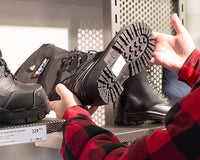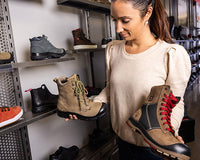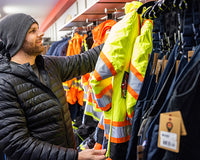It's not always easy to choose what to wear when you have to spend time outside in the spring and fall when the weather is wet and windy. Especially when it's mid-season and sometimes it's still too warm to take out the insulated coats. To guide you in your search, we will present you with different characteristics to consider. As specialists in worker protection and safety, we are able to present you with the different characteristics of a mid-season work coat.
Before going any further, let's establish together what a mid-season coat is. The main concern, of the majority of individuals, is to stay dry and warm when they are outside. No one likes to get wet when it rains. But that's what can happen in the spring and fall. The temperature is variable, the winds are strong and the days can be wet. It can be difficult to dress for the daily weather. That's why it's essential to choose a windproof or rain jacket that will protect you from these inclement weather conditions.
Waterproofing
It is important to determine your needs. If your job requires you to stay in the rain for long hours, choose a fully waterproof coat. These coats are made and woven, with water resistant materials, which allow the permeability of the garment. It can also be equipped with a waterproof membrane.
Soft shells, also known as softshells, provide some resistance to rain. However, they are not considered fully waterproof.

There are tests to determine the level of waterproofness of a garment. A column graduated in millimeters, filled with water, is applied to the sample. If the water does not penetrate the sample after a given time, it is considered waterproof. A fabric showing 2000 mm and more will be considered waterproof.
Protection against wind
We suggest that you choose a coat that protects against the wind. Loose fitting coats can allow air to slip under the coat. Nylon, polyester and polyurethane are resistant to strong winds. Softshell offers less resistance to wind gusts. Look closely at the information on the retailer's label to learn more about the coat's design and features.

Protection
It is agreed that a work coat must protect the individual from bad weather, but also protect him from the risks of his job. For this reason, in certain sectors such as transportation, construction, signage, etc., clothing must be equipped with reflective strips.
Some coats are equipped with anti-tear materials to protect the individual from lacerations. Finally, many suppliers offer multi-pocket garments that allow workers to store their work tools and thus have their hands free to do their work.
Breathability
Physical effort also has an impact on the breathability of the garment. If you plan to work physically, choose a coat with a membrane or a material that will offer maximum breathability. It is also preferable to have a coat that will offer ventilation in the armpits and sides. Conversely, more static work does not require a garment with significant breathability. In this case, you would be better off with an insulated coat.
Some coats are equipped with anti-tear materials to protect the individual from lacerations. Finally, many suppliers offer multi-pocket garments that allow workers to store their work tools and have their hands free to do their work.
Insulation
The interior insulation of a mid-season coat varies considerably from one model to another. Polyester, cotton and synthetic insulation is very popular in workwear. These are inexpensive solutions that offer good durability.

Synthetic insulations are designed more for high intensity activities. They offer good breathability and dry quickly.
Cotton allows heat to be stored. However, it is less breathable and dries less quickly than synthetic insulation.
Durability
Proper care of the coat will maximize its life span. Not excessive washing, with mild products, will help to preserve the waterproof properties and the resistance of the material. The quality of the seams, the strength of the material and its thickness will have a direct impact on the durability of the garment. Ask our advisors for more information on the durability of mid-season coats.
The look and its practicality
The cut, fit, hood, zippers and pockets are all elements to evaluate. A coat with a good fit will reduce the risk of injury as well as air and water infiltration. The hood, pockets and sealed zippers will allow the individual to stay dry and retain body heat.
Visit our website to see what mid-season coats are available or talk to a consultant in store!



